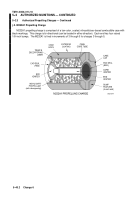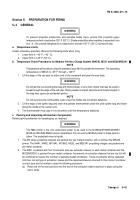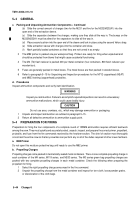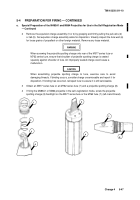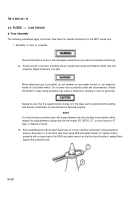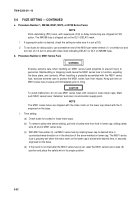TM-9-2350-311-10 - Page 577 of 775
TM 9--2350--311--10
Change 6
5--45
5--4
PREPARATION FOR FIRING — CONTINUED
b. Propelling Charges — Continued
3
For M203A1 propelling charge only, pull pull-straps until the buttons on the base igniter assembly clear
the mouth of the container. Grasp charge around the buttons and pull charge out of the container
supporting it along its length to avoid dropping the charge. Do not fire propelling charges which have
severely crushed or distorted cases and/or contain missing or broken propellant.
4
Remove the igniter cap and inspect the red igniter pad. The pad should not be torn or wet. The igniter
powder grains are highly hygroscopic (will absorb moisture) and could stick together, causing misfires.
The igniter powder grains should move freely inside the pad to show that they are not stuck together.
Unserviceable charges should be set aside for disposal by authorized personnel.
5
Check the smell of the powder charge and its container. There should not be a sour, acid smell as this
indicates the charge became wet. There should be a sweet ether-like smell, indicating that the charge is
fresh.
6
Remove any excess powder increments (those increments with a higher number than called for in the
fire command), and retighten the tie straps so that all powder increments are secure, with the highest
numbered charge (per fire command) on top.
7
Place the unused powder increments in a secure container and dispose of them later by burning under
the supervision of an officer.
c. Modular Artillery Charges System (MACS)
The MACS propelling charges are combustible case type charges that are packed in hermetically sealed metal containers.
The M231 MACS is packed with four modules (two per extraction sleeve) in each metal container. The M232/M232A1
MACS is packed with five modules in each metal container. Check for the following when preparing the propellant for firing:
1
Select the right charge announced in the fire command.
2
Unpack the charges from the metal container by pulling on the velcro strap to remove the sleeve with
the MACS enclosed from the container. Remove separator assembly by pulling on the connecting strap.
Open the velcro strap and remove end cushions from either end of the sleeves. Push the needed
amount of MACS from the opposite end of the sleeve through the now open end of the sleeve. Charges
that are severely crushed, distorted, or broken are not to be fired.
3
Check the red mylar seals on the end of the charges. If the seal is torn, punctured or missing, inspect
the igniter bag. The pad should not be torn or wet. The igniter powder grains are highly hygroscopic (will
absorb moisture): the grains will stick together, which could cause misfires. The igniter powder grains
should move freely inside the pad to show that they are not stuck together.
4
Unused MACS charges are repacked for later use
d. Projectiles
Projectiles for these howitzers normally come packed 8 to the pallet, with top and bottom of the wooden pallets banded
together. (For preparation of M712 (copperhead) projectile, see section III of this chapter.) Each projectile has a lifting plug
and a grommet attached for protection during shipping and handling activities. See paragraph 5--13 for the Loose Projectile
Restraint System (LPRS), which is an optional system for securing loose unfuzed projectiles for transportation.
NOTE
These procedures apply to all projectiles, except for the M483A1 and M864 projectiles when
used in the self-registration mode.
1
Preparation of projectiles. Cannoneer selects the right projectile announced in the fire commands and
prepares it for firing as follows.
(a) Inspects and cleans projectile.
Back to Top




